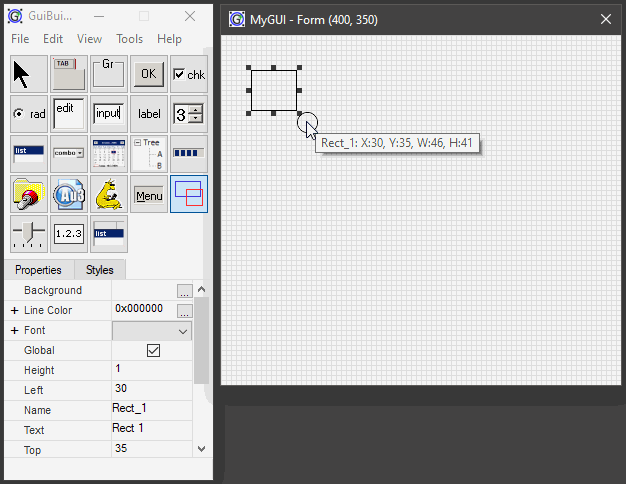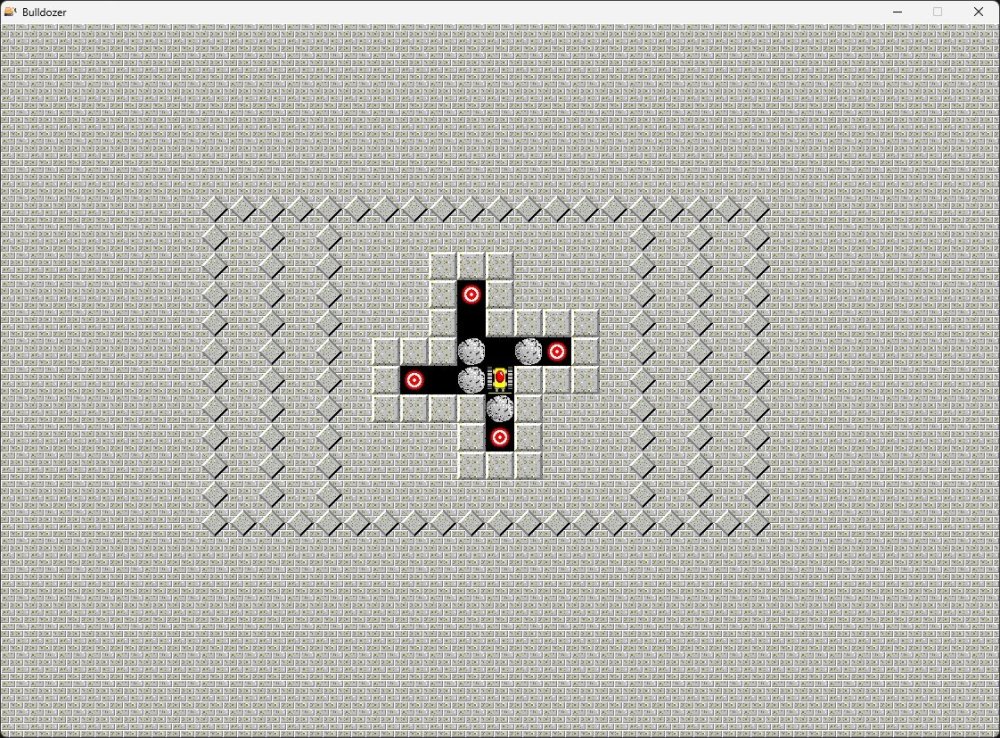Leaderboard
Popular Content
Showing content with the highest reputation on 04/26/2023 in all areas
-

GuiBuilderPlus [updated March 24, 2024]
Skeletor and 2 others reacted to kurtykurtyboy for a topic
3 points -
As per MSDN : See https://learn.microsoft.com/en-us/windows/win32/api/winuser/nf-winuser-registershellhookwindow Here my simple way to detect windows : #include <GUIConstants.au3> #include <APISysConstants.au3> #include <WinAPISysWin.au3> #include <Constants.au3> Global $hForm = GUICreate('') GUIRegisterMsg(_WinAPI_RegisterWindowMessage('SHELLHOOK'), WM_SHELLHOOK) _WinAPI_RegisterShellHookWindow($hForm) OnAutoItExitRegister(OnAutoItExit) Run('notepad.exe') Run('calc.exe') Local $sNotepadTitle = '[CLASS:Notepad]' Local $sCalculatorTitle = 'Calculatrice' WinWait($sNotepadTitle) WinWait($sCalculatorTitle) WinSetOnTop($sCalculatorTitle, '', $WINDOWS_ONTOP) WinActivate($sNotepadTitle) Sleep(1000) Func WM_SHELLHOOK($hWnd, $iMsg, $wParam, $lParam) Switch $wParam Case $HSHELL_WINDOWACTIVATED, $HSHELL_WINDOWCREATED, $HSHELL_RUDEAPPACTIVATED ConsoleWrite($lParam & "/" & WinGetTitle($lParam) & " has been activated" & @CRLF) Case $HSHELL_WINDOWDESTROYED ConsoleWrite($lParam & "/" & WinGetTitle($lParam) & " has been closed" & @CRLF) EndSwitch EndFunc ;==>WM_SHELLHOOK Func OnAutoItExit() _WinAPI_DeregisterShellHookWindow($hForm) EndFunc ;==>OnAutoItExit2 points
-
This works fine for me, added some performance related switches to the command-line. #include <WindowsConstants.au3> #include <StaticConstants.au3> #include <GUIConstantsEx.au3> #include <Constants.au3> Global $gui = GUICreate("Test Mplayer", @DesktopWidth, @DesktopHeight, 0, 0, $WS_POPUP, $WS_EX_TOPMOST) Global $hWnd = WinGetHandle("Test Mplayer") GUISetState(@SW_SHOW) Global $s_MPlayer_ARGs_Embed = "-slave -wid " & Number($hWnd) & " " #cs $run_dos_cmd_line = "mplayer.exe -vo directx " & $s_MPlayer_ARGs_Embed & "-identify -msglevel all=5 -lavdopts wait_keyframe -monitorpixelaspect 1 -priority abovenormal -progbar-align 95 -nofs -nodr -double -noslices -font C:\WINDOWS\fonts\verdana.ttf -subfont-autoscale 3 -subfont-osd-scale 4 -subfont-outline 1 -subfont-blur 1 -noautosub -colorkey 0 -input nodefault-bindings -noconsolecontrols -nofontconfig -nomouseinput -nosound -ao null -af volume=-200:0 -osdlevel 3 -lavdopts threads=4 03205.mp4" $i_PID_MPlayer = Run($run_dos_cmd_line, "", @SW_HIDE, $STDERR_MERGED + $STDIN_CHILD) #ce $i_PID_MPlayer = Run("mplayer.exe -vo direct3d " & $s_MPlayer_ARGs_Embed & "-identify -noborder -priority abovenormal -lavdopts threads=4 -noslices test.mov", @ScriptDir, @SW_HIDE, $STDIN_CHILD + $STDOUT_CHILD) ; StdinWrite($i_PID_MPlayer, "pause" & @LF) ; start MPlayer paused Local $b_Playback_Started = False While 1 Local $StdoutRead_Buffer = "" Local $StdoutRead_Line = "" Do $StdoutRead_Line = StdoutRead($i_PID_MPlayer) $StdoutRead_Buffer &= $StdoutRead_Line If StringInStr($StdoutRead_Buffer, 'Exiting... (End of file)', 2) Then ConsoleWrite('Exiting... (End of file)' & @CRLF) Exit 3 EndIf If StringLen($StdoutRead_Buffer) > 32768 Then ConsoleWrite("! $StdoutRead_Buffer > 32768 characters" & @CRLF) ; Exit EndIf StringReplace($StdoutRead_Buffer, "Too many buffered pts", "") If @extended > 10 Then ConsoleWrite("! Too many buffered pts" & @CRLF) ; Exit EndIf StringReplace($StdoutRead_Buffer, "Unexpected decoder output", "") If @extended > 10 Then ConsoleWrite("! ERROR - Unexpected decoder output" & @CRLF) Exit 4 EndIf $nMsg = GUIGetMsg() Switch $nMsg Case $GUI_EVENT_CLOSE Exit EndSwitch Until StringInStr($StdoutRead_Buffer, "Starting playback...", 2) Or $b_Playback_Started $b_Playback_Started = True If $StdoutRead_Buffer Then ConsoleWrite($StdoutRead_Buffer) WEnd2 points
-
This is a replication of an old game called Bulldozer created by John 'FlyMan' Hattan (The Code Zone). There is another implementation in AutoHotkey made by Weston Campbell so I made one in AutoIt. In Weston's github repository you can check the game objective and all valid movements and objects. The controls are: UP - Move bulldozer up DOWN - Move bulldozer down RIGHT - Move bulldozer right LEFT - Move bulldozer left R - Restart current level U - Undo last move J - Jump to a specific level PAUSE - Pause the game Currently I added just first 30 40 60 levels but the original game have 180 levels (eventually I will add all of them). Since Weston's code is on github I suppose it's under some kind of creative license so I didn't bother to create other sprites but if someone have time and inspiration to create new sprites, I am open to add new sprites. To do: Maybe some music Hall of fame / Score table Add all original game levels Add more custom levels Provide access to settings (fonts, colors, sprites, hotkeys, etc) In the attachment is a compiled executable and also the source code. #NoTrayIcon #include-once #include <GDIPlus.au3> #include <WinAPI.au3> #include <SQLite.au3> If Not FileExists(@ScriptDir & '\Bulldozer.sqlite') Then MsgBox(0x10, 'Error', 'Database could not be located!', 10) Exit EndIf _SQLite_Startup(@ScriptDir & '\sqlite3.dll') Global $hDB = _SQLite_Open(@ScriptDir & '\Bulldozer.sqlite') Global Const $TileSize = Number(ReadProperty('TileSize', 32)) Global Const $XTiles = Number(ReadProperty('XTiles', 35)) Global Const $YTiles = Number(ReadProperty('YTiles', 25)) If @DesktopWidth < $XTiles * $TileSize Or @DesktopHeight < $YTiles * $TileSize Then MsgBox(0x30, 'Warning', 'For a better experience you need a display with a resolution ' & String($XTiles * $TileSize) & 'x' & String($YTiles * $TileSize) & '.', 10) EndIf Global $X, $Y, $Direction Global $mResources[] Global $mTiles[] Global $aTiles = GetTiles() If IsArray($aTiles) Then For $Index = 1 To UBound($aTiles) - 1 If $aTiles[$Index][1] Then $mTiles[$aTiles[$Index][0]] = $aTiles[$Index][1] Next Else _SQLite_Close() _SQLite_Shutdown() MsgBox(0x10, 'Error', 'Cannot retrieve game tiles from database!', 10) Exit EndIf Global $CurrentLevel = 1 Global $MaxLevel = Number(ReadProperty('MaxLevel', 1)) Global $AutoRestart = Number(ReadProperty('AutoRestart', 0)) Global $Font = ReadProperty('Font', 'Segoe UI') Global $FontSize = Number(ReadProperty('FontSize', 40)) Global $SecFontSize = Number(ReadProperty('SMFontSize', 20)) Global $MessageColor = ReadProperty('MessageColor', 0xFFFFFFFF) Global $SecMessageColor = ReadProperty('SMColor', 0xFF00A000) Global $Start, $PlayTime = 0, $Pause = False, $MsgShow = False Global $LastMove = Null, $PrevLevel = Null, $NumOfMoves = 0 Global $hMain, $aLevel[$YTiles][$XTiles] Global $ClearColor = ReadProperty('ClearColor', '0xFF000000') Global $KeyboardEnabled = False _GDIPlus_Startup() $mResources['Bitmap'] = _GDIPlus_BitmapCreateFromScan0($XTiles * $TileSize, $YTiles * $TileSize) $mResources['Graphics'] = _GDIPlus_ImageGetGraphicsContext($mResources['Bitmap']) _GDIPlus_GraphicsSetCompositingMode($mResources['Graphics'], 0) _GDIPlus_GraphicsSetCompositingQuality($mResources['Graphics'], 2) _GDIPlus_GraphicsSetInterpolationMode($mResources['Graphics'], 2) _GDIPlus_GraphicsSetSmoothingMode($mResources['Graphics'], 2) _GDIPlus_GraphicsSetTextRenderingHint($mResources['Graphics'], 3) For $Index = 1 To UBound($aTiles) - 1 If $aTiles[$Index][2] Then $mResources[$aTiles[$Index][0]] = _GDIPlus_BitmapCreateFromMemory(Unpack($aTiles[$Index][2])) Next $hMain = GUICreate('Bulldozer', $XTiles * $TileSize, $YTiles * $TileSize) $hPic = GUICtrlCreatePic('', 0, 0, $XTiles * $TileSize, $YTiles * $TileSize) GUISetState(@SW_SHOW, $hMain) LoadLevel() DrawLevel() DrawBulldozer($mResources['Bulldozer' & $Direction]) PushToScreen() While True If GUIGetMsg() = -3 Then Quit() If LevelDone() Then NextLevel() If WinActive($hMain) Then If $KeyboardEnabled = False Then KeyboardInput(True) Else If $KeyboardEnabled Then KeyboardInput(False) EndIf Sleep(10) WEnd Func Quit() Local $aKeys = MapKeys($mResources) For $Index = 0 To UBound($aKeys) - 1 $aKeys[$Index] = 'Graphics' ? _GDIPlus_GraphicsDispose($mResources[$aKeys[$Index]]) : _GDIPlus_BitmapDispose($mResources[$aKeys[$Index]]) Next _GDIPlus_Shutdown() _SQLite_Close() _SQLite_Shutdown() Exit EndFunc Func KeyboardInput($Set = True) Local $aKeys = GetKeyboard() If IsArray($aKeys) Then For $Index = 1 To UBound($aKeys) - 1 HotKeySet($aKeys[$Index][0], $Set ? $aKeys[$Index][1] : Null) Next EndIf $KeyboardEnabled = $Set EndFunc Func MoveRight() If $Pause Or $MsgShow Then Return $PrevLevel = $aLevel IsMovable($X + 1, $Y) If $X + 1 < $XTiles And IsMovable($X + 1, $Y) Then If IsRock($X + 1, $Y) And (IsEmpty($X + 2, $Y) Or IsEmptySocket($X + 2, $Y)) Then $aLevel[$Y][$X + 1] = IsSocket($X + 1, $Y) ? $mTiles['Socket'] : $mTiles['None'] $aLevel[$Y][$X + 2] = IsEmpty($X + 2, $Y) ? $mTiles['Rock'] : $mTiles['RockSocket'] $X += 1 ElseIf IsRock($X + 1, $Y) And (Not IsMovable($X + 2, $Y) Or IsRock($X + 2, $Y)) Then $X = $X Else $X += 1 EndIf $NumOfMoves += 1 EndIf $LastMove = 'R' DrawLevel() DrawBulldozer($mResources['BulldozerR']) PushToScreen() EndFunc Func MoveLeft() If $Pause Or $MsgShow Then Return $PrevLevel = $aLevel If $X - 1 > 0 And IsMovable($X - 1, $Y) Then If IsRock($X - 1, $Y) And (IsEmpty($X - 2, $Y) Or IsEmptySocket($X - 2, $Y)) Then $aLevel[$Y][$X - 1] = IsSocket($X - 1, $Y) ? $mTiles['Socket'] : $mTiles['None'] $aLevel[$Y][$X - 2] = IsEmpty($X - 2, $Y) ? $mTiles['Rock'] : $mTiles['RockSocket'] $X -= 1 ElseIf IsRock($X - 1, $Y) And (Not IsMovable($X - 2, $Y) Or IsRock($X - 2, $Y)) Then $X = $X Else $X -= 1 EndIf $NumOfMoves += 1 EndIf $LastMove = 'L' DrawLevel() DrawBulldozer($mResources['BulldozerL']) PushToScreen() EndFunc Func MoveUp() If $Pause Or $MsgShow Then Return $PrevLevel = $aLevel If $Y - 1 > 0 And IsMovable($X, $Y - 1) Then If IsRock($X, $Y - 1) And (IsEmpty($X, $Y - 2) Or IsEmptySocket($X, $Y - 2)) Then $aLevel[$Y - 1][$X] = IsSocket($X, $Y - 1) ? $mTiles['Socket'] : $mTiles['None'] $aLevel[$Y - 2][$X] = IsEmpty($X, $Y - 2) ? $mTiles['Rock'] : $mTiles['RockSocket'] $Y -= 1 ElseIf IsRock($X, $Y - 1) And (Not IsMovable($X, $Y - 2) Or IsRock($X, $Y - 2)) Then $Y = $Y Else $Y -= 1 EndIf $NumOfMoves += 1 EndIf $LastMove = 'U' DrawLevel() DrawBulldozer($mResources['BulldozerU']) PushToScreen() EndFunc Func MoveDown() If $Pause Or $MsgShow Then Return $PrevLevel = $aLevel If $Y + 1 < $YTiles And IsMovable($X, $Y + 1) Then If IsRock($X, $Y + 1) And (IsEmpty($X, $Y + 2) Or IsEmptySocket($X, $Y + 2)) Then $aLevel[$Y + 1][$X] = IsSocket($X, $Y + 1) ? $mTiles['Socket'] : $mTiles['None'] $aLevel[$Y + 2][$X] = IsEmpty($X, $Y + 2) ? $mTiles['Rock'] : $mTiles['RockSocket'] $Y += 1 ElseIf IsRock($X, $Y + 1) And (Not IsMovable($X, $Y + 2) Or IsRock($X, $Y + 2)) Then $Y = $Y Else $Y += 1 EndIf $NumOfMoves += 1 EndIf $LastMove = 'D' DrawLevel() DrawBulldozer($mResources['BulldozerD']) PushToScreen() EndFunc Func IsMovable($CX, $CY) If $CX < 0 Or $CX >= $XTiles Then Return False If $CY < 0 Or $CY >= $YTiles Then Return False Switch $aLevel[$CY][$CX] Case $mTiles['None'], $mTiles['Rock'], $mTiles['RockSocket'], $mTiles['Socket'] Return True Case Else Return False EndSwitch EndFunc Func IsRock($CX, $CY) If $CX < 0 Or $CX >= $XTiles Then Return False If $CY < 0 Or $CY >= $YTiles Then Return False Switch $aLevel[$CY][$CX] Case $mTiles['Rock'], $mTiles['RockSocket'] Return True Case Else Return False EndSwitch EndFunc Func IsEmpty($CX, $CY) If $CX < 0 Or $CX >= $XTiles Then Return False If $CY < 0 Or $CY >= $YTiles Then Return False Switch $aLevel[$CY][$CX] Case $mTiles['None'] Return True Case Else Return False EndSwitch EndFunc Func IsEmptySocket($CX, $CY) If $CX < 0 Or $CX >= $XTiles Then Return False If $CY < 0 Or $CY >= $YTiles Then Return False Switch $aLevel[$CY][$CX] Case $mTiles['Socket'] Return True Case Else Return False EndSwitch EndFunc Func IsSocket($CX, $CY) If $CX < 0 Or $CX >= $XTiles Then Return False If $CY < 0 Or $CY >= $YTiles Then Return False Switch $aLevel[$CY][$CX] Case $mTiles['RockSocket'], $mTiles['Socket'] Return True Case Else Return False EndSwitch EndFunc Func JumpToLevel() Local $iLevel = InputBox('Jump to level', 'Please type the level that you want to play') If $iLevel And Int($iLevel) > 0 And Int($iLevel) <= $MaxLevel Then $CurrentLevel = $iLevel LoadLevel() DrawLevel() DrawBulldozer($mResources['Bulldozer' & $Direction]) PushToScreen() EndIf EndFunc Func LevelDone() For $j = 0 To $YTiles - 1 For $i = 0 To $XTiles - 1 If $aLevel[$j][$i] = $mTiles['Socket'] Then Return False Next Next Return True EndFunc Func NextLevel() $PlayTime += Int(TimerDiff($Start) / 1000) ShowMessage('Level ' & $CurrentLevel & ' completed.' & @CRLF & ' ', 'Solved in ' & $NumOfMoves & ' moves.' & @CRLF & 'Time: ' & FormatTime($PlayTime), 4000) If $CurrentLevel + 1 > $MaxLevel Then GameEnd() Else $CurrentLevel += 1 LoadLevel() DrawLevel() DrawBulldozer($mResources['Bulldozer' & $Direction]) PushToScreen() EndIf EndFunc Func LoadLevel() Local $Data = SQLite_Query($hDB, 'SELECT Data FROM levels WHERE Level = ' & $CurrentLevel) If @extended Then $Data = BinaryToString(Unpack($Data[1][0])) $Data = StringSplit($Data, @CRLF, 1) For $Line = 1 To $YTiles Local $Row = StringSplit($Data[$Line], '') For $Index = 1 To $Row[0] $aLevel[$Line - 1][$Index - 1] = $Row[$Index] Next Next $X = $Data[26] $Y = $Data[27] $Direction = $Data[28] ShowMessage('Level ' & $CurrentLevel) $NumOfMoves = 0 $PlayTime = 0 $Start = TimerInit() EndIf EndFunc Func RestartLevel() If $Pause Then Return LoadLevel() DrawLevel() DrawBulldozer($mResources['Bulldozer' & $Direction]) PushToScreen() EndFunc Func GameEnd() ShowMessage('Congratulations!' & @CRLF & @CRLF & 'You have finished the game.', Null, 4000) If $AutoRestart Then $CurrentLevel = 1 RestartLevel() Else Quit() EndIf EndFunc Func FormatTime($Sec) If $Sec < 60 Then Return $Sec & ' seconds' Local $Min = Int($Sec / 60) $Sec -= $Min * 60 If $Min > 60 Then Local $Hours = Int($Sec / 60) $Min -= $Hours * 60 Return $Hours & ' hour' & ($Hours > 1 ? 's' : '') & ($Min <> 0 ? ', ' & $Min & ' minute' & ($Min > 1 ? 's' : '') : '') & ($Sec <> 0 ? ', ' & $Sec & ' second' & ($Sec > 1 ? 's' : '') : '') Else Return $Min & ' minute' & ($Min > 1 ? 's' : '') & ($Sec <> 0 ? ', ' & $Sec & ' second' & ($Sec > 1 ? 's' : '') : '') EndIf EndFunc Func ShowMessage($Message, $SecMessage = Null, $iDelay = 1500) $MsgShow = True Local $hFamily = _GDIPlus_FontFamilyCreate($Font) Local $hFont = _GDIPlus_FontCreate($hFamily, $FontSize, 1) Local $tLayout = _GDIPlus_RectFCreate(0, 0, $XTiles * $TileSize, ($SecMessage ? ($YTiles * $TileSize / 2) : ($YTiles * $TileSize))) Local $hBrush = _GDIPlus_BrushCreateSolid($MessageColor) Local $hFormat = _GDIPlus_StringFormatCreate() _GDIPlus_StringFormatSetAlign($hFormat, 1) _GDIPlus_StringFormatSetLineAlign($hFormat, ($SecMessage ? 2 : 1)) _GDIPlus_GraphicsClear($mResources['Graphics'], $ClearColor) _GDIPlus_GraphicsDrawStringEx($mResources['Graphics'], $Message, $hFont, $tLayout, $hFormat, $hBrush) If $SecMessage Then _GDIPlus_StringFormatSetLineAlign($hFormat, 0) Local $hSecFont = _GDIPlus_FontCreate($hFamily, $SecFontSize, 1) Local $tSecLayout = _GDIPlus_RectFCreate(0, ($YTiles * $TileSize / 2) , $XTiles * $TileSize, $YTiles * $TileSize / 2) Local $hSecBrush = _GDIPlus_BrushCreateSolid($SecMessageColor) _GDIPlus_GraphicsDrawStringEx($mResources['Graphics'], $SecMessage, $hSecFont, $tSecLayout, $hFormat, $hSecBrush) EndIf PushToScreen() _GDIPlus_StringFormatDispose($hFormat) _GDIPlus_BrushDispose($hBrush) _GDIPlus_FontDispose($hFont) If $SecMessage Then _GDIPlus_BrushDispose($hSecBrush) _GDIPlus_FontDispose($hSecFont) EndIf _GDIPlus_FontFamilyDispose($hFamily) Local $DelayTimer = TimerInit() Do If GUIGetMsg() = -3 Then Quit() Sleep(10) Until TimerDiff($DelayTimer) >= $iDelay $MsgShow = False EndFunc Func UndoLastMove() If $PrevLevel = Null Then Return If $LastMove = Null Then Return If $Pause Then Return $aLevel = $PrevLevel DrawLevel() Switch $LastMove Case 'R' $X -= 1 DrawBulldozer($mResources['BulldozerR']) Case 'L' $X += 1 DrawBulldozer($mResources['BulldozerL']) Case 'U' $Y += 1 DrawBulldozer($mResources['BulldozerU']) Case 'D' $Y -= 1 DrawBulldozer($mResources['BulldozerD']) EndSwitch PushToScreen() $PrevLevel = Null $NumOfMoves -= 1 EndFunc Func Pause() $Pause = Not $Pause If $Pause Then $PlayTime += Int(TimerDiff($Start) / 1000) ShowMessage('Game is paused.', 'Press {Pause} button to resume your game.', 10) Else DrawLevel() DrawBulldozer($mResources['Bulldozer' & $Direction]) PushToScreen() $Start = TimerInit() EndIf Do Sleep(10) Until $Pause = False EndFunc Func DrawLevel() _GDIPlus_GraphicsClear($mResources['Graphics'], $ClearColor) For $j = 0 To $YTiles - 1 For $i = 0 To $XTiles - 1 Switch $aLevel[$j][$i] Case $mTiles['Wall1'] _GDIPlus_GraphicsDrawImageRect($mResources['Graphics'], $mResources['Wall1'], $i * $TileSize, $j * $TileSize, $TileSize, $TileSize) Case $mTiles['Wall2'] _GDIPlus_GraphicsDrawImageRect($mResources['Graphics'], $mResources['Wall2'], $i * $TileSize, $j * $TileSize, $TileSize, $TileSize) Case $mTiles['Wall3'] _GDIPlus_GraphicsDrawImageRect($mResources['Graphics'], $mResources['Wall3'], $i * $TileSize, $j * $TileSize, $TileSize, $TileSize) Case $mTiles['Wall4'] _GDIPlus_GraphicsDrawImageRect($mResources['Graphics'], $mResources['Wall4'], $i * $TileSize, $j * $TileSize, $TileSize, $TileSize) Case $mTiles['Wall5'] _GDIPlus_GraphicsDrawImageRect($mResources['Graphics'], $mResources['Wall5'], $i * $TileSize, $j * $TileSize, $TileSize, $TileSize) Case $mTiles['Wall6'] _GDIPlus_GraphicsDrawImageRect($mResources['Graphics'], $mResources['Wall6'], $i * $TileSize, $j * $TileSize, $TileSize, $TileSize) Case $mTiles['Wall7'] _GDIPlus_GraphicsDrawImageRect($mResources['Graphics'], $mResources['Wall7'], $i * $TileSize, $j * $TileSize, $TileSize, $TileSize) Case $mTiles['Wall8'] _GDIPlus_GraphicsDrawImageRect($mResources['Graphics'], $mResources['Wall8'], $i * $TileSize, $j * $TileSize, $TileSize, $TileSize) Case $mTiles['Rock'] _GDIPlus_GraphicsDrawImageRect($mResources['Graphics'], $mResources['Rock'], $i * $TileSize, $j * $TileSize, $TileSize, $TileSize) Case $mTiles['RockSocket'] _GDIPlus_GraphicsDrawImageRect($mResources['Graphics'], $mResources['RockSocket'], $i * $TileSize, $j * $TileSize, $TileSize, $TileSize) Case $mTiles['Socket'] _GDIPlus_GraphicsDrawImageRect($mResources['Graphics'], $mResources['Socket'], $i * $TileSize, $j * $TileSize, $TileSize, $TileSize) EndSwitch Next Next EndFunc Func DrawBulldozer($hImage) _GDIPlus_GraphicsDrawImageRect($mResources['Graphics'], $hImage, $X * $TileSize, $Y * $TileSize, $TileSize, $TileSize) EndFunc Func PushToScreen() Local $hHBITMAP = _GDIPlus_BitmapCreateHBITMAPFromBitmap($mResources['Bitmap']) _WinAPI_DeleteObject(GUICtrlSendMsg($hPic, 0x0172, 0, $hHBITMAP)) _WinAPI_DeleteObject($hHBITMAP) EndFunc Func ReadProperty($sProperty, $vFallback = Null) Local $aQuery = SQLite_Query($hDB, "SELECT Value FROM settings WHERE Property = " & _SQLite_FastEscape($sProperty)) If @extended Then Return $aQuery[1][0] Else Return $vFallback EndIf EndFunc Func GetTiles($vFallback = Null) Local $aQuery = SQLite_Query($hDB, 'SELECT Tile, Symbol, Data FROM tiles') If @extended Then Return $aQuery Else Return $vFallback EndIf EndFunc Func GetKeyboard($vFallback = Null) Local $aQuery = SQLite_Query($hDB, 'SELECT Key, Function FROM keyboard') If @extended Then Return $aQuery Else Return $vFallback EndIf EndFunc Func SQLite_Query($hDB, $sQuery) Local $aResult, $iRows, $iColumns _SQLite_GetTable2d($hDB, $sQuery, $aResult, $iRows, $iColumns) If @error Then Return SetError(1, 0, False) Else Return SetError(0, UBound($aResult, 1) - 1, $aResult) EndIf EndFunc Func Unpack($bData) Local $tData = DllStructCreate('byte Data[' & BinaryLen($bData) & ']') Local $bCode = Binary('0x8B7424048B4C2408AC347F8846FF4975F7C20800') Local $iSize = BinaryLen($bCode) Local $tCode = DllStructCreate('byte Code[' & $iSize & ']') DllStructSetData($tCode, 'Code', $bCode) DllStructSetData($tData, 'Data', $bData) DllCallAddress('int', DllStructGetPtr($tCode), 'ptr', DllStructGetPtr($tData), 'int', DllStructGetSize($tData)) Return DllStructGetData($tData, 'Data') EndFunc Have fun! Bulldozer.zip1 point
-

Implementing Windows Explorer right pane
pixelsearch reacted to LarsJ for a topic
Note that this is a real Windows Explorer. But only the right pane. All functionality of Windows Explorer is working. E.g. keyboard shortcuts, the context (right click) menu, cut, copy, paste, drag & drop and automatic update of the window. Implementations There are three implementations: An implementation for Vista, 7 and 8, an implementation for Windows XP, and a SysListView32 based implementation for Vista, 7 and 8. The latter is named SysLv32.au3 in the examples. This is more or less the Windows XP implementation adapted for Vista, 7 and 8. Functionality The implementations are based on Shell interfaces. This means that most functionality of Windows Explorer is working automatically without any additional code. Other features: Position Explorer window in GUISpecify root and start foldersSpecify an initial icon view modeSpecify an icon view mode for the DesktopSpecify a file filter to filter files by extensionUse folder flags $FWF_NOBACKBROWSING, $FWF_SINGLESEL and $FWF_NOSUBFOLDERSBrowse to child/parent folder with Enter/Backspace keysDelete, disable and insert items in the context menuExecute context menu commands in codeDocumentation Use ExplorerWindowCreate() to create the right pane window. This function is located in Explorer\<Implementation>\WindowsExplorer.au3. You find documentation for the function in top of the file. Documentation for the Vista, 7, 8 implementation is included in the Examples section below. Ini file To handle Rename, New and View in the context menu, it's necessary to be able to identify these items. This seems only to be possible to do, by identifying the names. Because the names are localized, an ini file is used to store the names. Especially the View command depends on the ini file. If the View command isn't recognized, the icon view modes are not set properly. Rename and New commands are depending on the ini file, when the commands are selected with the keyboard. More information in the sections below. First release 2013-11-28 In first release Explorer right pane windows are created with enough functionality to get it to work. There are two implementations: One for Vista, 7 and 8, and one for Windows XP. First update 2014-03-14 This update consists primarily of bug fixes in first release. Because both APIConstants.au3 and WinAPIEx.au3 are included, the scripts can't run on AutoIt 3.3.10 without modifications. A new implementation for Vista, 7 and 8 is added. This implementation is based on a SysListView32 control. This is more or less the Windows XP implementation adapted for Vista, 7 and 8. Second update 2014-04-23 The implementations are based on Shell interfaces, and most functionality of Windows Explorer is working automatically. But you still have to integrate that functionality into your script. Especially you have to take care of keystrokes in combination with various controls and windows. E.g. the rename edit box, the context menu and dialog boxes. This update introduces an ini file: Explorer\Inifiles\ContextMenu.ini Third update 2014-05-02 The third update is mostly about the context menu. It's divided into two parts. The first part is about manipulating the context menu. The example shows how to delete, disable and add custom menu items. The second part shows how to execute context menu commands in code. The example implements Cut, Copy and Paste buttons. The spoiler section starts with an explanation of the message flow and message handlers. Final release 2014-05-10 Left, top, width and height parameters are added to the ExplorerWindowCreate() function. This makes it easier to position the Explorer window in the GUI. When the GUI is resized, the Explorer window is resized so that margins are retained. The margins can be used for buttons or other controls. The new parameters are implemented in the examples. Redundant code is moved from example files to common files. Some minor bug fixes. This is the final release of the small examples. It should not be too difficult to reuse the examples and code. I'm currently working on a large example where an address bar, a toolbar, a left pane and a status bar is implemented besides the right pane. This is a much bigger example, and it'll be more difficult to reuse the code. I'll probably add this example to a new thread. Final release, Vista update 2014-06-21 The Vista, 7, 8 example in first release dated 2013-11-28 was based on Vista code. The XP example was based on XP code. But most of the additional code in the next updates was XP code (see post 40). This meant that some functionality wasn't implemented completely under Vista and later. E.g. icon view modes. Examples The zip contains seven folders at the top level: 1. Basic example2. Position and size3. Navigation buttons4. Toolbar example5. Context menu6. Cut-copy-pasteExplorerThe first six folders are examples. The Explorer folder contains common files and includes. Resources specific for a particular example are contained in the example folder. There are three scripts for each example: Vista, 7, 8.au3, SysLv32.au3 and Windows XP.au3. Other examples (Vista and later) in posts below: Three examples where all panes are implemented (not just the right pane)You can find an example which implements the other panes in this post.This example shows how to merge all include files into a single Include folder.Implement proper tab order between LV and TV, and update LV on up/down keys in TV here.An example that shows how to cancel drag/drop operations can be found here. AutoIt 3.3.8 If you want to run the scripts on AutoIt 3.3.8 you need APIConstants.au3 and WinAPIEx.au3 by Yashied. The UDFs are not included in the zip. You must enable the UDFs in top of ShellFunctions.au3. The UDFs are already added, but commented out. And you must comment out the 3.3.10 UDFs in ShellFunctions.au3 and WERPFuncs.au3. Testet on XP 32 bit and Win 7 32/64 bit. The scripts can be run as both 32 and 64 bit programs. If you are running a 64 bit Windows you should run the scripts as 64 bit programs. Windows Explorer right pane.7z1 point -

Sqlite remplace INI functions need optimization.
argumentum reacted to mistersquirrle for a topic
Keep in mind the overhead with SQLite calls from AutoIt. You're calling the DLL to do stuff in SQL, get data back and do something with it. It's a lot easier to read an ini file. Here's your posted version comparison: [================= Run progress, 10,000 times * 2 functions ===================] +———————————————+—————————————————+———————————————+——————————————+—————————————+ | Function Name | Time Taken (ms) | Avg Time (ms) | Std Dev (ms) | Faster By % | +———————————————+—————————————————+———————————————+——————————————+—————————————+ +| IniRead | 681.45 | 0.0681 | 0.0180 | 94.97 | | _DbRead_ | 13559.59 | 1.3560 | 0.2351 | 0.00 | +———————————————+—————————————————+———————————————+——————————————+—————————————+ And with @argumentum's suggestion of only doing [StartUp and Shutdown], [Open and Close] once: [================= Run progress, 10,000 times * 2 functions ===================] +———————————————+—————————————————+———————————————+——————————————+—————————————+ | Function Name | Time Taken (ms) | Avg Time (ms) | Std Dev (ms) | Faster By % | +———————————————+—————————————————+———————————————+——————————————+—————————————+ +| IniRead | 760.12 | 0.0760 | 0.0265 | 87.07 | | _DbRead_2 | 5878.42 | 0.5878 | 0.1161 | 0.00 | +———————————————+—————————————————+———————————————+——————————————+—————————————+ So, if all you're after is a couple of basic configuration options, I'd recommend sticking with a .ini file. If they're options that don't need to be constantly written/read, SQLite can work fine for getting options once at the start of the script, though you should probably create a function to get a whole 'section' of values at once, instead of one by one.1 point -
As I already told you, _GUICtrlToolbar_ClickButton is based on MouseClick and you also said that MouseClick is working. So there is something wrong in your code ( @Danp2 may have just nailed it ). Another way to check if the click is performed correctly, make the click move the cursor : _GUICtrlToolbar_ClickButton($hWnd, $iCmdID, "left", True) ; will move the cursor to the click area ps. put some consoleWrite here and there to follow the path of your script and post both your new script and the console result here... FYI. buttons are 0-based -- so loop should start at 0 not 11 point
-
Bildozer, Here you go - setting the timeout value to a negative value doubles the size of the countdown font: ExtMsgBox_Mod.au3 Or you can try this one where you need to add 128 to the $iStyle parameter of _ExtMsgBoxSet: ExtMsgBox_ModSet.au3 Which do you prefer? M231 point






